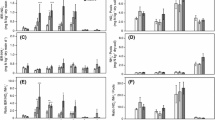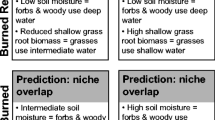Abstract
Aims
Global change agents are creating novel climatic and edaphic conditions that may favor introduced species. We attempted to identify mechanisms and impacts of Bromus tectorum invasion in the Colorado Front Range mixed-grass prairie under changing conditions.
Methods
We conducted an in-situ experiment with three removal treatments (removal of B. tectorum, removal of Pascopyrum smithii, and no removal) and two nitrogen treatments (ambient and low N), and measured plant community response. We used isotopic analysis of δ18O and δD in plants and soils to identify seasonal source water of B. tectorum and P. smithii.
Results
We found that dominance of B. tectorum was greatest under high resource conditions (ambient N, wet winter) now common due to increased N deposition and climate change. However, its removal had little impact on native plant abundance or composition. Isotopic results show B. tectorum and P. smithii partitioning water use between shallow versus deeper soil layers during the dry summer season.
Conclusions
Our results suggest that changing environmental conditions favor the introduced grass Bromus tectorum over native species, but probably not due to altered competitive relationships. Instead, B. tectorum appears to be opportunistically responding to expansion of a phenological niche and increased nutrient availability.





Similar content being viewed by others
References
Asbjornsen H, Shepherd G, Helmers M, Mora G (2008) Seasonal patterns in depth of water uptake under contrasting annual and perennial systems in the Corn Belt region of the Midwestern US. Plant Soil 308:69–92. doi:10.1007/s11104-008-9607-3
Baron JS, Rueth HM, Wolfe AM (2000) Ecosystem responses to nitrogen deposition in the Colorado front range. Ecosystems 3:352–368
Beals S, Hartley LM, Prevéy JS, Seastedt TR (2014) The effects of black-tailed prairie dogs on plant communities within a complex urban landscape: an ecological surprise? Ecology 95:1349–1359
Belnap J, Phillips SL (2001) Soil biota in an ungrazed grassland: response to annual grass (Bromus tectorum) invasion. Ecol Appl 11:1261–1275
Belnap J, Phillips SL, Sherrod SK, Moldenke A (2005) Soil biota change after exotic plant invasion: does this affect ecosystem processes? Ecology 86:3007–3017
Bozzolo FH, Lipson DA (2013) Differential responses of native and exotic coastal sage scrub plant species to N additions and the soil microbial community. Plant Soil 371:37–51
Bradley BA, Wilcove DS (2009) When invasive plants disappear: transformative restoration possibilities in the western United States resulting from climate change. Restor Ecol 17:715–721
Bradley BA, Blumenthal DM, Wilcove DS, Ziska LH (2010) Predicting plant invasions in an era of global change. Trends Ecol Evol 25:310–318
Brooker RW (2006) Plant-plant interactions and environmental change. New Phyt 171:271–284
Brooks ML, D’Antonio CM, Richardson DM, Grace JB, Keeley JE, DiTomaso JM, Hobbs RJ, Pellant M, Pyke D (2004) Effects of invasive alien plants on fire regimes. Bioscience 54:677–688
Cherwin KL, Seastedt TR, Suding KN (2009) Effects of nutrient manipulations and grass removal on cover, species composition, and invasibility of a novel grassland in Colorado. Restor Ecol 17:818–826
Concilio AC, Nippert JB, Ehrenfeuchet S, Cherwin K, Seastedt TR (2016a) Imposing antecedent global change conditions rapidly alters plant community composition in a mixed-grass prairie. Oecologia 182:899–911. doi:10.1007/s00442-016-3684-4
Concilio AC, Prevéy JP, Omasta P, O’Connor J, Nippert JB, Seastedt TR (2015a) Response of a mixed grass prairie to an extreme precipitation event. Ecosphere 6:172
Concilio AC, Seastedt TR, Nippert JB (2016b) Data from: “changing edaphic conditions and exploitation of an expanded phenological niche allows for increased exotic plant species dominance”. Figshare. doi:10.6084/m9.figshare.4341020.v1
Concilio AC, Vargas T, Cheng W (2015b) Rhizosphere-mediated effects of the invasive grass Bromus tectorum L. and native Elymus elymoides on nitrogen cycling in Great Basin desert soils. Plant Soil 393:245–257
Corbin JD, D’Antonio CM (2011) Gone but not forgotten? Invasive plants’ legacies on community and ecosystem properties. Inv Plant Sci Manage 5:117–124
Coupland RT, Johnson RE (1965) Rooting characteristics of native grassland species of Saskatchewan. J Ecol 53:475–507
D’Antonio CM, Vitousek PM (1992) Biological invasions by exotic grasses, the grass-fire cycle, and global change. Annu Rev Ecol Syst 23:63–87
Dawson TE, Mambelli S, Plamboeck AH, Templer PH, Tu KP (2002) Stable isotopes in plant ecology. Ann Rev Ecol Syst 33(1):507–559. doi:10.1146/annurev.ecolsys.33.020602.095451
Dukes JS, Chiariello NR, Loarie SR, Field CB (2011) Strong response of an invasive plant species (Centaurea solstitialis L.) to global environmental changes. Ecol Appl 21:1887–1894
Karl MG, Heitschmidt RK, Haferkamp MR (1999) Vegetation biomass dynamics and patterns of sexual reproduction in a northern mixed-grass prairie. Am Midl Nat 141:227–237
Knapp PA (1996) Cheatgrass (Bromus tectorum L) dominance in the Great Basin desert. Global Environ Chang 6:37–52
Haferkamp MR, Heitschmidt RK, Karl MG (1998) Clipping and Japanese brome reduce western wheatgrass standing crop. J Range Manag 51:692–698
Haferkamp MR, Heitschmidt RK (1999) Japanese brome impacts on western wheatgrass in northern Great Plains rangelands: an update. Great Plains Res 9:315–327
HillRisLanbers J, Yelenik SG, Colman BP, Levnie JM (2010) California annual grass invaders: the drivers or passengers of change? J Ecol 98:1147–1156
Ives AR (1995) Predicting the responses of populations to environmental change. Ecology 76:926–941
Leff JW, Jones SE, Prober SM, Barberán A, Borer ET, Firn JL, Harpole WS et al (2015) Consistent responses of soil microbial communities to elevated nutrient inputs in grasslands across the globe. PNAS 112:10967–10972
Littscheager J, Lauerer M, Blagodatskaya E, Kuzyakov Y (2010) Nitrogen uptake and utilization as a competition factor between invasive Duchesnea indica and native Fragaria vesca. Plant Soil 331:105–114
MacDougall AS, Gilbert B, Levine JM (2009) Plant invasions and the niche. J Ecol 97:609–615
MacDougall AS, Turkington R (2005) Are invasive species the drivers or passengers of change in degraded ecosystems? Ecology 86:42–55
Mack RN (1981) Invasion of Bromus tectorum L. into western North America: an ecological chronicle. Agro-Ecosystems 7:145–165
[NRCS] Natural Resources Conservation Service (2001) Web Soil Survey. United States Department of Agriculture. http://websoilsurvey.nrcs.usda.gov/app/WebSoilSurvey.aspx
Nippert JB, Knapp AK (2007) Soil water partitioning contributes to species coexistence in tallgrass prairie. Oikos 116:1017–1029
O’Conner J, Prevéy JS, Seastedt TR (2015) Effects of short-term soil conditioning by cheatgrass and western wheatgrass. Prairie Naturalist 47:65–72
Parnell AC, Inger R, Bearhop S, Jackson AL (2010) Source partitioning using stable isotopes: coping with too much variation. PLoS One 5:e9672. doi:10.1371/journal.pone.0009672
Parmesan C (2006) Ecological and evolutionary responses to recent climate change. Annu Rev Ecol Evol S 37:637–669
Porensky LM, Blumenthal DM (2016) Historical wildfires do not promote cheatgrass invasion in a western Great Plains steppe. Biol Invasions 18:333–3349. doi:10.1007/s10530-016-1225-z
Prevéy JS (2014) Precipitation change in a semi-arid grassland: plant community responses and management strategies. Dissertation, University of Colorado, Boulder
Prevéy JS, Seastedt TR (2014) Seasonality of precipitation interacts with invasive species to alter composition and phenology of a semi-arid grassland. J Ecol 102:1549–1561
Pyšek P, Richardson DM (2007) Traits associated with invasiveness in alien plants: where do we stand? In: Nentwig W (ed) Biological Invasions. Springer-Verlag, Heidelberg, pp 97–125
Risser P (1988) Abiotic controls on primary productivity and nutrient cycles in North American grasslands. In: Pomeroy LR, Alberts JJ (eds) Concepts of ecosystem ecology, vol 67. Springer-Verlag, New York, pp 115–129
Rysavy A, Seifan M, Sternberg M, Tielborger K (2016) Neighbor effects on shrub seedling establishment override climate change impacts in a Mediterranean community. J Veg Sci 27:227–237
Seabloom EW, Harpole WS, Reichman OJ, Tilman D (2003) Invasion, competitive dominance, and resource use by exotic and native California grassland species. PNAS 100:13384–13389
Smith SD, Huxman TE, Zitzer SF, Charlet TN, Housman DC, Coleman JS, Fenstermaker LK, Seemann JR, Nowak RS (2000) Elevated CO2 increases productivity and invasive species success in an arid ecosystem. Nature 408:79–82
Stark JM, Norton JM (2015) The invasive annual cheatgrass increases nitrogen availability in 24-year-old replicated field plots. Oecologia 177(3):799–809
Tirmenstein, D (1999) Pascopyrum smithii. In: Fire Effects Information System. U.S. Department of Agriculture, Forest Service, Rocky Mountain Research Station, Fire Sciences Laboratory. URL: http://www.fs.fed.us/database/feis/
Tylianakis JM, Didham RK, Bascompte J, Wardle DA (2008) Global change and species interactions in terrestrial ecosystems. Ecol Lett 11:1351–1363
Vermeire LT, Crowder JL, Wester DB (2011) Plant community and soil environment response to summer fire in the northern Great Plains. Range Ecol Manage 64:37–46
Weaver, JE (1966) Prairie plants and their environment: a fifty-year study in the Midwest. Univ. of Nebraska Press
Wolkovich EM, Cleland EE (2011) The phenology of plant invasions: a community ecology perspective. Front Ecol Environ 9:287–294
Zouhar, K (2003) Bromus tectorum. In: Fire Effects Information System. U.S. Department of Agriculture, Forest Service, Rocky Mountain Research Station, Fire Sciences Laboratory. URL: http://www.fs.fed.us/database/feis/plants/graminoid/brotec/all.html
Acknowledgements
This research was funded by a grant from the NSF (DEB 1120390) to the University of Colorado. We thank Robin Reibold, Peter Omasta, Shivani Ehrenfeucht, Jeremy Arkin, Katherine Hurtado, Summer Sugg, Michael Mann, Oren Rabinowitz, Kimberly O’Keefe and Rachel Lease for help with field sampling and lab analysis. We also thank L. and S. Sanabria for permission to use their property for this research effort.
Author information
Authors and Affiliations
Corresponding author
Additional information
Responsible Editor: Hans Lambers.
Electronic supplementary material
Online Resource 1
Total inorganic N collected by resin bags seasonally in ambient and low N plots (DOCX 331 kb).
Online Resource 2
Results from 2-way PerMANOVAs of raw and 4th root transformed species composition data (full dataset) (DOCX 75 kb).
Online Resource 3
Results from 2-way PerMANOVAs of raw and 4th root transformed species composition data (all species aside from focal species B. tectorum and P. smithii) (DOCX 76 kb).
Online Resource 4
Introduced species dominance in June 2013 compared to June 2014 by removal and nitrogen treatments (DOCX 556 kb).
Online Resource 5
Results from an isotopic mixing model showing the estimated proportion of water used by B. tectorum and P. smithii from different parts of the soil profile in spring and summer of 2014 (DOCX 422 kb).
Rights and permissions
About this article
Cite this article
Concilio, A.L., Seastedt, T.R. & Nippert, J.B. Changing edaphic conditions and exploitation of an expanded phenological niche allows for increased exotic (introduced) plant species dominance. Plant Soil 415, 299–315 (2017). https://doi.org/10.1007/s11104-016-3167-8
Received:
Accepted:
Published:
Issue Date:
DOI: https://doi.org/10.1007/s11104-016-3167-8




